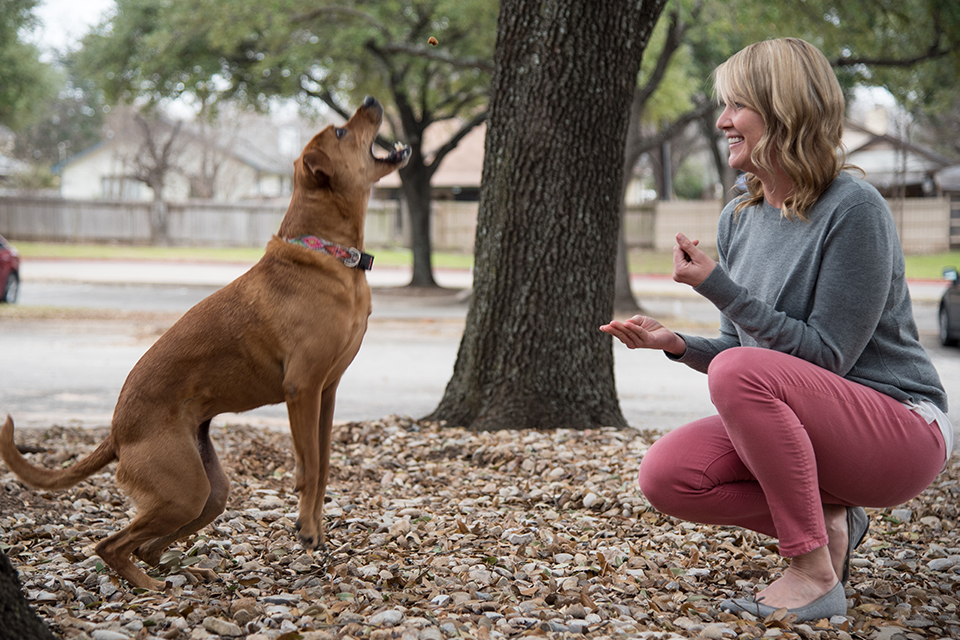Medical FAQ: Veterinary

Let’s be honest: there’s more to taking care of your pup than the occasional belly scratch. To help us break down the ABC’s of giving our furry friends healthy, happy lives, we turned to Dr. Samantha Taylor. Although Dr. Taylor’s known around Sunbury Veterinary Clinic as an avid marathon runner—including a Boston marathon finish, a testament to her training alongside running partner, Poppy (pictured)— she places her clients’ pet fitness above all else.
What is the most common breed of dog you see at your practice? Why do you think that is?
Our clinic predominantly caters to English and French bulldogs because the owner of our practice owns these breeds. This, paired with the fact that these dogs—especially Frenchies—are rapidly increasing in popularity, has enabled us to become very well-versed with treating their breed-specific health issues. We also see a lot of mixed breed dogs and mutts because Austin has really focused on adoption through no-kill shelters and rescue organizations.
Let’s say I’m a first-time dog owner. What are a few early health indicators to look out for if I’ve adopted a pup from a rescue shelter?
Shelters usually require a veterinarian to examine a dog within a few weeks of being adopted to check for parasites, update vaccinations, and evaluate its overall health. Before the first vet visit, new owners should watch out for coughing and sneezing, which are signs of upper respiratory infections that are commonly spread in shelters. They should also make sure the dog has a good appetite, is taking normal poops, and isn’t bothered by any itchiness or hairless spots.
Austin is a major running city. How concerned should owners be about running with their pups during the summer, when the streets and sidewalks are extremely hot and can potentially damage their dogs’ pads?
I’m a long distance runner who has a dog for a running partner, and it makes me so concerned when I see people running with their dogs in the heat of the day! Their tender pads can burn within a minute of walking or running on the hot asphalt, and heat stroke is a real issue. It's better to exercise early in the morning or later in the evening. I never take my dog running if it's above 85 degrees outside and the midday sun is shining—and she’s accustomed to 13-plus mile runs on leash.
Some of the most popular dogs in Austin—Australian Shepherds, Labs, Collies—are also some of the most active. Do you have any exercise guidelines that owners can follow to ensure their dog is as active as it should be?
A long daily walk is a good starting place, but some breeds require more. One thing to always consider when selecting a dog breed is what it was originally bred for. Dogs bred for working (like those referenced above) need to be exercised daily, which is one of the reasons they can develop behavioral issues or become destructive—they get bored and need to be worn out! They may require an extensive off-leash session of hiking, running, fetching, or playing with other dogs, rather than your typical 20-minute daily walk.
On the flip side, how can owners of less active dogs—Bulldogs, Pugs, Great Danes, for example—get their dogs the exercise they need without pushing them too hard?
Many breeds—especially brachycephalic (flat-faced) ones—have been designed and bred for less active lifestyles. It doesn't mean they don't enjoy crazy play and walks, but rather they simply cannot handle the length and intensity of exercise that a longer snouted dog can. They are more likely to suffer heat strokes and should not be left outside on a hot day for an extended amount of time. As a result, they need shorter walks at cooler temperatures. This requires a great deal of care from their owners—if your dog stops and sits down when you’re out on a walk, then you’ve gone too far.






